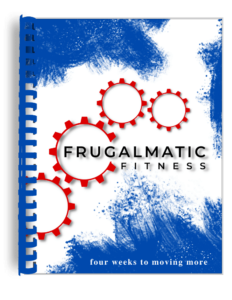This post was last updated on December 16th, 2022 at 07:17 pm
An assumption people make about becoming more physically active is that it’s largely a physical process. In reality, it’s mostly mental. You need to form the physically active mindset to be able to consistently act on your ideas for moving more and sitting less.
Of course, physically active people have different approaches. There’s no one way to be physically active, but I have noticed the physically active mindset shares these three qualities:
01 The physically active mindset calculates the cost of convenience
Many people view convenience as only beneficial. They don’t see a downside, but this kind of thinking can fuel a sedentary lifestyle. The truth is, we’re often blind to the cost of convenience because we’re bombarded with television and internet ads characterizing physical effort as burdensome—with the glaring exception of exercise machines and athletic-type products. In our consumer-driven economy, we celebrate physical achievements that achieve nothing practical: Sweating for the sake of sweating. Meanwhile, we’re encouraged to eliminate movement from our everyday, regular routines.
Here’s an example of what I mean: I recently received a promotional flier for a grocery delivery service stating, “Join today and stop wasting time at the grocery store.”
For many people, shopping is a good source of physical activity. It can add hundreds of steps to your day, depending on how many groceries you need. If you eliminate those trips by signing up for a grocery delivery service, the question becomes, “How do you plan to make up that lost physical activity?” Because grocery shopping isn’t a one-and-done responsibility. You shop week after week, with thousands of steps taken over the course of a year.
When you acknowledge a cost of convenience, you’re more selective about which conveniences you allow into your life. In being more selective it’s easier to stay physically active: Biking to work instead of taking Uber. Using a push lawnmower instead of a riding mower. Hanging laundry on a clothesline instead of using a dryer. Maintaining a vegetable garden instead of purchasing all your veggies. The possibilities are truly limitless.
02 The physically active mindset creates “triggers”
People who are physically active don’t possess special powers. Rather, many of them rely on “triggers” to sustain physical activity levels. A trigger can be a visual cue or an event occurring on a regular, ideally daily, basis. For example, an empty refrigerator can be a “trigger” to go to the grocery store. If you work in an office, entering the building can “trigger” you to take the stairs. At home, finishing a load of laundry can “trigger” you to use a clothesline.
Some triggers are more permanent than others, and we can become more sedentary when we lack triggers. It’s happened to me, and I’ll explain more about that later. Life events, such as relocating or starting a new job, can destroy triggers, but they also can create opportunities for new ones.
A good example of somebody who uses triggers is Charlie Tennessen, whom I interviewed a few weeks ago. He grows much of his own food and operates a stone-ground flour mill.
As he explained it to me, “If you put me in a room full of Coca-Cola and candy bars, I’d just have the Coca-Colas and candy bars. But if I put myself on a farm, I have to exercise every day as part of farming. My garden is 600 feet away from where I am right now in my office. I had to walk there several times today, carrying things back and forth.
“Once you grow something, you get attached to it, and so you have to eat it. It really is a personal way to make myself behave better and be a healthier person.”
For Charlie, farming responsibilities act as a trigger; they “force” him to stay physically active.
Of course, you don’t have to farm to create triggers. Believe it or not, hydration can be used as a trigger. It’s especially helpful if you have a desk job like me. By making sure I stay properly hydrated, I use the restroom more often. This simple, mundane act breaks up my sitting time. Triggers can be big or small. The key is to identify them and incorporate them into your daily routine.
Not surprisingly, the times in my life that I’ve struggled to be physically active involved an upheaval of my routine. Several years ago, I switched jobs and relocated but had to leave my family behind until we could find a new house near where I worked. I ended up renting a room in a home for several months, and then on the weekends drove seven hours to visit my family. I lost all my triggers that had kept me physically active before switching jobs. Needless to say, I gained almost 20 pounds!
It wasn’t until my family found a house, and I settled into my job that I was able to identify new triggers and get back into a physically active routine. The extra weight then disappeared. Without triggers, a physically active lifestyle doesn’t come easy for me. With those triggers in place, it’s like being on cruise control.
03 The physically active mindset focuses on location, location, location
To be physically active, it helps to put yourself in an environment that promotes the creation of meaningful triggers. The physically active mindset seeks out the “sweet spot” between convenience and inconvenience, recognizing that if a certain action is too inconvenient, you can’t trigger it.
Here’s an example: While it’s great to bike to work, most people can’t afford to spend more than 30 minutes or so of their morning on the road. A bike commute must be an acceptable distance and fit into your schedule. That makes the location of where you live relative to where you work an important consideration.
When I mentioned I had gained weight after switching jobs years ago, it was partly because my family was struggling to find a new house. The search dragged on for months. I kept my fingers crossed, hoping we could find a house within biking distance of my workplace. The fact is, I had been biking to my workplaces since the early 2000s. So I was relieved when the house we decided to purchase also happened to be one mile from my office. I regained one of my most powerful triggers.
The location also allowed our family to walk to church, numerous parks, and a pharmacy, leading to the creation of additional “triggers.”
Keep in mind, location isn’t just about where you live. The location of anything—whether a garden, tool shed, laundry room, or office cubicle—can affect your physical activity levels. A good location makes walking or riding a bike practical, while a poor location can make being physically active impractical. You want to seek out that “sweet spot”—not too far away but not too close, either.
The Frugalmatic Fitness process for moving more
Ultimately, these three qualities of the physically active mindset—calculating the cost of convenience, creating triggers, and seeking out location “sweet spots”—work together. For example, it’s not enough to live within a couple miles of your workplace. You also need that “trigger” to hop onto your bike each morning.
Arguably, the most difficult concept to learn is the cost of convenience, particularly with regard to technology. We’re all taught and encouraged to use the latest and greatest tech, believing it will improve our lives in some way. But as the internet has demonstrated, particularly with the rise of social media, more is not always better. If you’re not selective about your technology, you risk “engineering” movement out of your routine.


Don’t feel discouraged if you experience a setback on your way to becoming more physically active. It’s a process. As long as you’re being intentional and becoming more aware of what it means to be physically active, you’re headed in the right direction.
If you are motivated to become physically active but would benefit from more guidance, I encourage you to try Frugalmatic Fitness. I developed this simple, step-by-step program to mirror the physically active mindset. The program is customizable to suit your own environment and physical abilities. Frugalmatic Fitness will give you the focus to gradually add new movements to your routine over a period of 30 days. And once they become an established part of your routine, these new movements can become healthy new habits.
And once they’re new habits, you’ve arrived. You’ve created your own physically active mindset!

